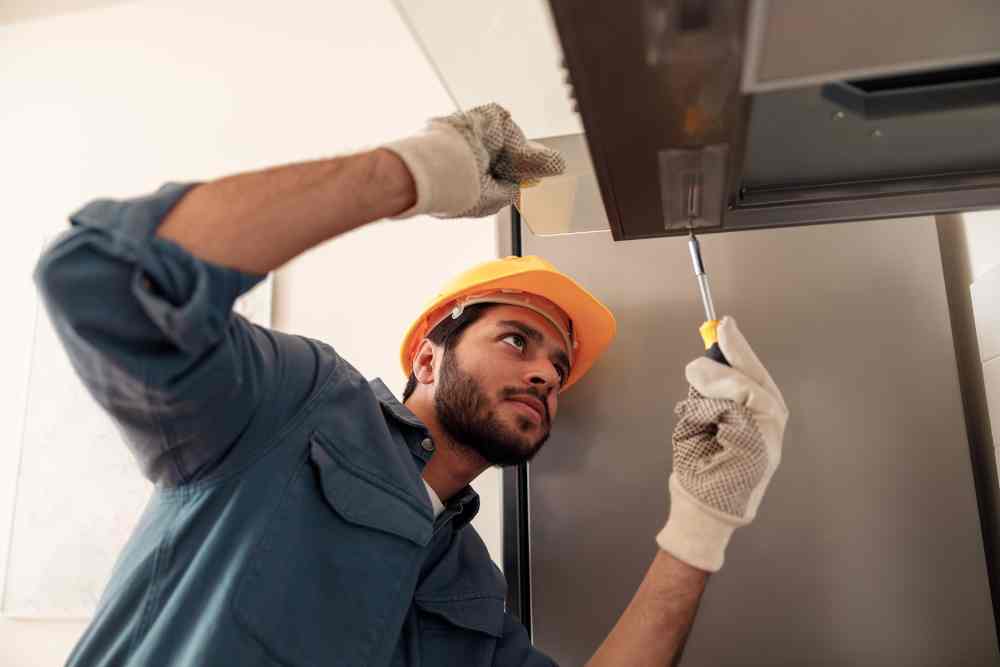Tips for Proper Ventilation of Cooking Exhaust

Cooking is an essential part of our daily lives, but it can also generate a significant amount of smoke, odors, and airborne particles. Without proper ventilation, these byproducts can accumulate in our homes, leading to poor indoor air quality and potential health hazards. In this article, we will explore the importance of proper ventilation for cooking exhaust and provide valuable tips to ensure a healthy and comfortable living environment.
Ontario-wide Kitchen Exhaust and Hood Cleaning – Best prices and service guaranteed.
The Importance of Proper Ventilation
Proper ventilation is crucial for removing pollutants and maintaining good indoor air quality. When cooking, various pollutants are released into the air, including carbon monoxide, nitrogen dioxide, volatile organic compounds (VOCs), and particulate matter. These pollutants can have detrimental effects on our health, especially if we are exposed to them for extended periods.
Ontario-wide Kitchen Exhaust and Hood Cleaning – Best prices and service guaranteed.
Exposure to high levels of carbon monoxide can lead to symptoms such as headaches, dizziness, and even death in severe cases. Nitrogen dioxide, commonly produced by gas stoves, can cause respiratory problems, especially in individuals with asthma or other respiratory conditions. VOCs, found in cooking oils, can contribute to the formation of smog and have been linked to respiratory irritation and long-term health effects.
Proper ventilation helps to remove these pollutants from the air, reducing the risk of health problems and creating a more comfortable living environment. It also helps to control moisture levels, preventing the growth of mold and mildew, which can further impact indoor air quality.
Ontario-wide Kitchen Exhaust and Hood Cleaning – Best prices and service guaranteed.
Tips for Effective Ventilation
Now that we understand the importance of proper ventilation, let’s explore some tips to ensure effective removal of cooking exhaust:
1. Install a Range Hood
A range hood is a vital component of any kitchen ventilation system. It is designed to capture and remove cooking fumes, smoke, and odors directly from the source. When choosing a range hood, consider the size of your cooktop and the airflow capacity of the hood. A larger cooktop may require a more powerful hood to effectively remove all the pollutants.
Additionally, opt for a range hood that vents to the outside rather than recirculating the air. While recirculating hoods may be more convenient to install, they are less effective at removing pollutants from the air. Vented hoods direct the exhaust outdoors, preventing it from re-entering the living space.
Ontario-wide Kitchen Exhaust and Hood Cleaning – Best prices and service guaranteed.
2. Position the Range Hood Correctly
The positioning of the range hood plays a crucial role in its effectiveness. Ideally, the hood should be installed directly above the cooktop, with the bottom of the hood positioned 24 to 30 inches above the cooking surface. This ensures that the hood captures the maximum amount of pollutants and prevents them from spreading throughout the kitchen.
It is also important to consider the size of the range hood in relation to the cooktop. The hood should extend at least 3 inches beyond each side of the cooktop to effectively capture all the cooking exhaust.
3. Clean and Maintain the Range Hood Regularly
A range hood can only function effectively if it is clean and well-maintained. Over time, grease and other debris can accumulate in the hood and its filters, reducing its efficiency. Regularly clean the hood and filters according to the manufacturer’s instructions to ensure optimal performance.
Additionally, inspect the ductwork connected to the range hood for any blockages or damage. A blocked or damaged duct can hinder the airflow and reduce the effectiveness of the ventilation system. If necessary, hire a professional to clean or repair the ductwork.
Ontario-wide Kitchen Exhaust and Hood Cleaning – Best prices and service guaranteed.
4. Use Natural Ventilation
In addition to a range hood, natural ventilation can also help to remove cooking exhaust. Open windows and doors to allow fresh air to enter the kitchen and carry away the pollutants. However, this method may not be as effective as a range hood, especially in areas with poor outdoor air quality or during extreme weather conditions.
5. Consider Supplementary Ventilation
In some cases, a range hood alone may not be sufficient to adequately ventilate the cooking area. Supplementary ventilation options, such as kitchen exhaust fans or downdraft systems, can be considered. These systems work in conjunction with the range hood to further remove cooking exhaust and improve indoor air quality.
Ontario-wide Kitchen Exhaust and Hood Cleaning – Best prices and service guaranteed.
Case Study: The Impact of Proper Ventilation
A study conducted by the Environmental Protection Agency (EPA) examined the impact of proper ventilation on indoor air quality in homes with gas stoves. The study found that homes with properly installed and operated range hoods had significantly lower levels of nitrogen dioxide compared to homes without range hoods or with range hoods that were not used consistently.
The study also highlighted the importance of venting range hoods to the outside. Homes with range hoods that vented to the outside had lower levels of pollutants compared to homes with recirculating range hoods.
Ontario-wide Kitchen Exhaust and Hood Cleaning – Best prices and service guaranteed.
Proper ventilation of cooking exhaust is essential for maintaining good indoor air quality and a healthy living environment. By installing a range hood, positioning it correctly, and regularly cleaning and maintaining it, you can effectively remove pollutants and improve the air quality in your kitchen. Additionally, considering natural ventilation and supplementary ventilation options can further enhance the effectiveness of your ventilation system.
Remember, the key to proper ventilation is to remove pollutants at the source and direct them outdoors. By following these tips, you can ensure that your cooking activities do not compromise the air quality in your home, allowing you to enjoy a safe and comfortable living environment.
Learn more about “Best Method of Kitchen Vent Cleaning for Ventilation” here.
Frequently Asked Questions about Tips for Proper Ventilation of Cooking Exhaust

What Are the Best Practices for Ventilating Cooking Exhaust?
Proper ventilation of cooking exhaust is essential for both safety and efficiency in the kitchen. Below are some best practices:
Install an Adequate Exhaust Hood: Choose an exhaust hood that is the right size and type for your specific cooking needs. A system that is too small won’t efficiently remove smoke and odors.
Regular Maintenance: Keep the filters, fans, and ducts clean and in optimal condition to ensure that the system functions correctly. Regular maintenance also extends the life of your system and reduces fire risks.
Use High-Efficiency Filters: Upgrading to high-efficiency grease filters can significantly improve smoke and odor removal without reducing airflow.
Balanced Airflow: Make sure to maintain a balanced airflow in the kitchen. An imbalance can cause poor air quality and can even affect the efficiency of other appliances.
Proper Ductwork: Ensure that the ducts are installed correctly and are free from obstructions for efficient air removal.
How Important is the Exhaust Fan Speed in Ventilating Cooking Exhaust?
The speed of the exhaust fan plays a crucial role in effective ventilation:
Higher Speeds for High-Volume Cooking: When cooking food that produces a lot of smoke or odors, such as frying or grilling, a higher fan speed is essential for efficient removal.
Variable Speeds for Different Cooking Tasks: Having a variable-speed fan allows you to adjust the ventilation based on your current needs, saving energy when full power isn’t required.
Speed and Noise: Keep in mind that higher speeds often result in more noise. If noise is a concern, look for high-efficiency, low-noise fans.
What Role Do Filters Play in Cooking Exhaust Ventilation?
Filters are the first line of defense in your ventilation system:
Grease Filtration: Standard metal filters trap grease particles, reducing the risk of fire.
Smoke and Odor Control: Carbon filters can remove smoke and odors but need to be replaced regularly.
Efficiency: High-efficiency filters can improve airflow and require less frequent cleaning but are generally more expensive.
Selecting the right type of filter based on your specific needs is crucial for effective ventilation.
Can Opening Windows Substitute for a Cooking Exhaust System?
While opening windows can provide some level of ventilation, it is not a substitute for a proper cooking exhaust system for several reasons:
Inconsistent Airflow: Wind direction and speed are unpredictable and may not effectively remove cooking exhaust.
Safety Risks: Without a proper exhaust system, there is a higher risk of accumulating harmful gases like carbon monoxide and grease which can lead to fire hazards.
Inefficiency: Manually opening and closing windows is not practical in a busy kitchen and does not guarantee proper ventilation.
What Are Some Common Mistakes to Avoid for Proper Cooking Exhaust Ventilation?
Avoid these common pitfalls for better ventilation:
Ignoring Regular Maintenance: Neglecting regular cleaning and maintenance can lead to reduced efficiency and increased fire risks.
Wrong Hood Size: Installing a hood that is too small for your cooking volume will lead to poor ventilation.
Blocking Air Vents: Never block air vents with items like paper towels or cooking utensils.
Ignoring Filter Replacement: Not replacing or cleaning filters regularly can lead to poor air quality and increased fire risks.
By following these tips and best practices, you can significantly improve the efficiency and safety of your kitchen’s exhaust ventilation system.
- hood cleaning
- kitchen exhaust cleaning
- restaurant hood cleaning
- Tips for Proper Ventilation of Cooking Exhaust






